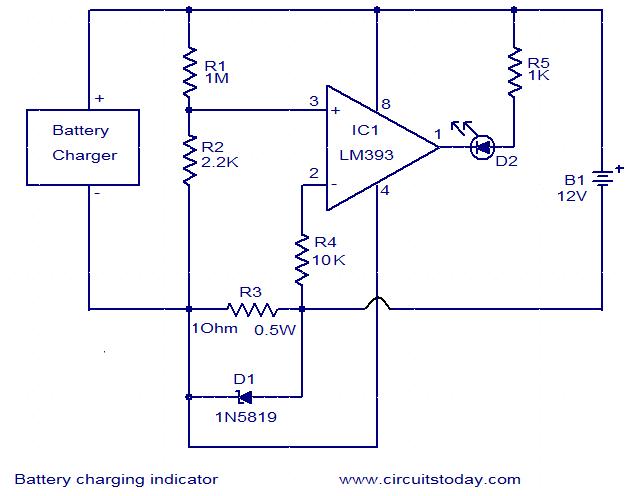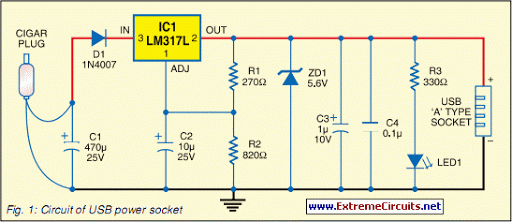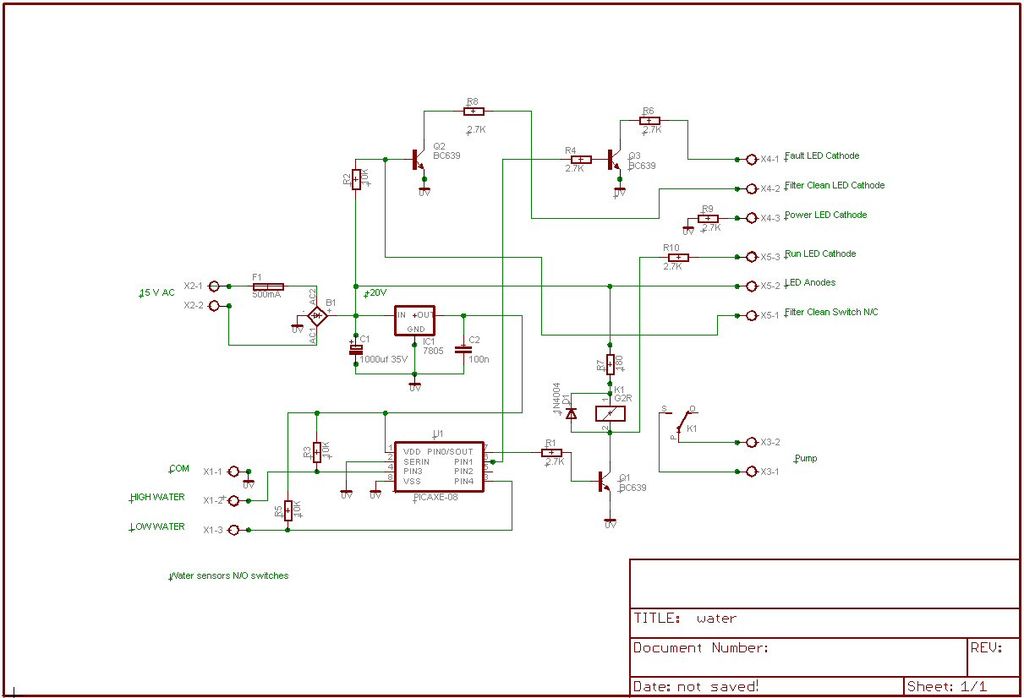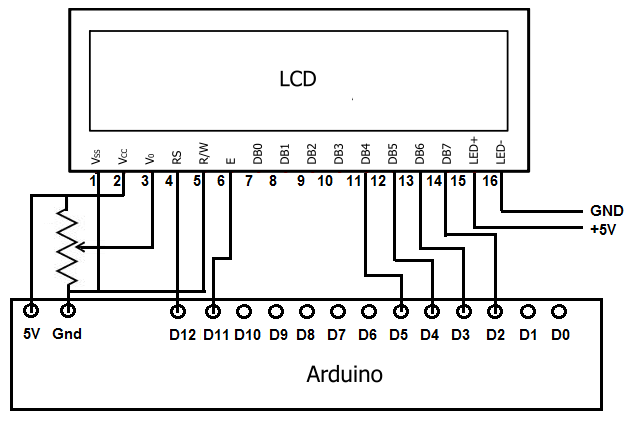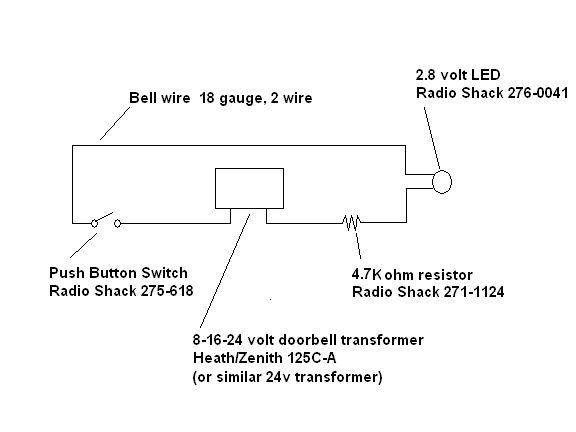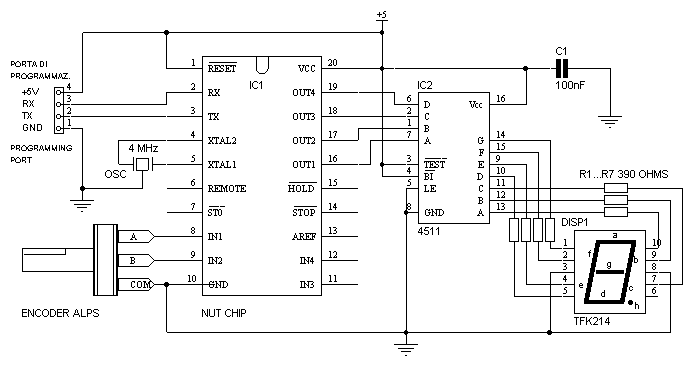
Water Level Indicator With 7-Segment Display PCB
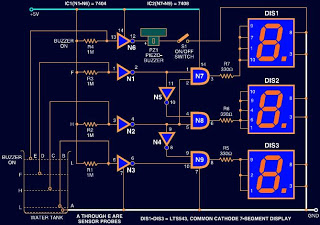
Circuits designed to indicate water levels typically consist of LEDs to represent the liquid level. However, this circuit utilizes a 7-segment LED display instead of standard LEDs for a numeric representation of the water level. Additionally, a buzzer is incorporated to alert users when the tank is overflowing. The circuit displays "L," "H," and "F" for low, half, and full water levels, respectively. This circuit can be employed for water tank motor control or as a standalone device. The pins of the IC 7404 (NOT gate IC) are pulled high through a 1M ohm resistor, resulting in a low output voltage. As the tank fills with water, a low voltage is present at the input pins of the gate, causing it to output a high voltage. When the water level rises to touch the low-level sensor, pin 5 of gate N3 receives a low voltage, leading to a high output at pin 6. Since pin 6 of the gate is connected to pin 10 of gate N9, pin 10 also becomes high. Consequently, with both pins 9 and 10 of gate N9 high, its output pin 8 also goes high. This results in a positive supply being applied to DIS3, displaying "L" to indicate a low water level in the tank.
This water level indication circuit employs a 7-segment LED display for clear numeric representation, enhancing visibility compared to traditional LED indicators. The inclusion of a buzzer provides an auditory alert for overflow conditions, ensuring that users are promptly notified to prevent potential water spillage. The circuit operates based on the principles of digital logic using the 7404 NOT gate IC, which is configured to respond to varying input voltages corresponding to the water level.
The 1M ohm resistor serves a dual purpose: it pulls the gate input high under normal conditions and establishes a reference voltage level for the operation of the circuit. As water fills the tank, the conductive properties of the water engage the low-level sensor, which is strategically placed to trigger the necessary logic changes in the circuit. The cascading logic levels from the NOT gates effectively convert the analog water level into a digital signal that can be interpreted by the display.
The display outputs "L" when the water level is low, transitioning to "H" for half-full and "F" for full, allowing for easy monitoring of the tank's status. This design can be integrated into automated water tank systems where it can control the motor operation based on the water level readings, thereby enhancing efficiency and convenience. The circuit's modular design allows for adaptability in various applications, making it suitable for both residential and industrial water management systems.Circuits available for indicating water level is usually consist of LEDs to indicate the liquid level. But this circuit uses a 7-segment LED display instead of normal LED`s for numeric display of water level.
Moreover, a buzzer is used to alert you of water overflowing from the tank. The circuit shows the water level by displaying L, H and F for lo w, half and full, respectively. You can use this circuit for water tank motor control or a stand alone circuit. pins of IC 7404 (NOT gate IC) are pulled high via a 1M ohm resistor. So it outputs a low voltage. As water starts filling the tank, a low voltage is available at the input pins of the gate and it outputs a high voltage. When the water in the tank rises to touch the low level sensor, pin 5 of gate N3 gets a low voltage and results in high output at pin 6.
Pin 6 of the gate is connected to pin 10 of gate N9, so pin 10 also goes high. Now as both pins 9 and 10 of gate N9 are high, its output pin 8 also goes high. As a result, positive supply is applied to DIS3 and it shows L` indicating low level of water in the tank. 🔗 External reference
This water level indication circuit employs a 7-segment LED display for clear numeric representation, enhancing visibility compared to traditional LED indicators. The inclusion of a buzzer provides an auditory alert for overflow conditions, ensuring that users are promptly notified to prevent potential water spillage. The circuit operates based on the principles of digital logic using the 7404 NOT gate IC, which is configured to respond to varying input voltages corresponding to the water level.
The 1M ohm resistor serves a dual purpose: it pulls the gate input high under normal conditions and establishes a reference voltage level for the operation of the circuit. As water fills the tank, the conductive properties of the water engage the low-level sensor, which is strategically placed to trigger the necessary logic changes in the circuit. The cascading logic levels from the NOT gates effectively convert the analog water level into a digital signal that can be interpreted by the display.
The display outputs "L" when the water level is low, transitioning to "H" for half-full and "F" for full, allowing for easy monitoring of the tank's status. This design can be integrated into automated water tank systems where it can control the motor operation based on the water level readings, thereby enhancing efficiency and convenience. The circuit's modular design allows for adaptability in various applications, making it suitable for both residential and industrial water management systems.Circuits available for indicating water level is usually consist of LEDs to indicate the liquid level. But this circuit uses a 7-segment LED display instead of normal LED`s for numeric display of water level.
Moreover, a buzzer is used to alert you of water overflowing from the tank. The circuit shows the water level by displaying L, H and F for lo w, half and full, respectively. You can use this circuit for water tank motor control or a stand alone circuit. pins of IC 7404 (NOT gate IC) are pulled high via a 1M ohm resistor. So it outputs a low voltage. As water starts filling the tank, a low voltage is available at the input pins of the gate and it outputs a high voltage. When the water in the tank rises to touch the low level sensor, pin 5 of gate N3 gets a low voltage and results in high output at pin 6.
Pin 6 of the gate is connected to pin 10 of gate N9, so pin 10 also goes high. Now as both pins 9 and 10 of gate N9 are high, its output pin 8 also goes high. As a result, positive supply is applied to DIS3 and it shows L` indicating low level of water in the tank. 🔗 External reference
